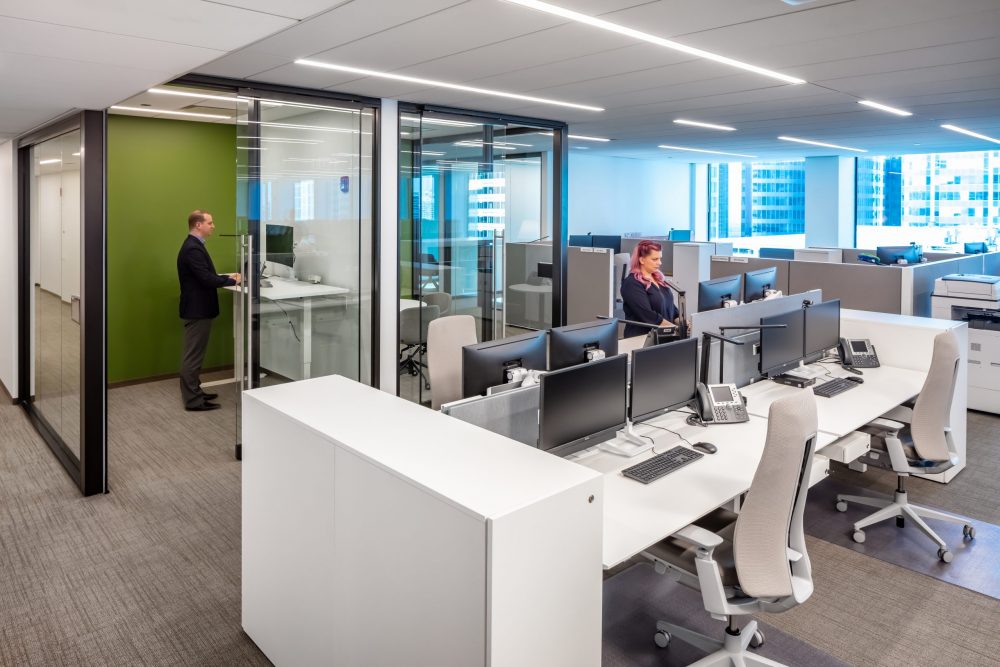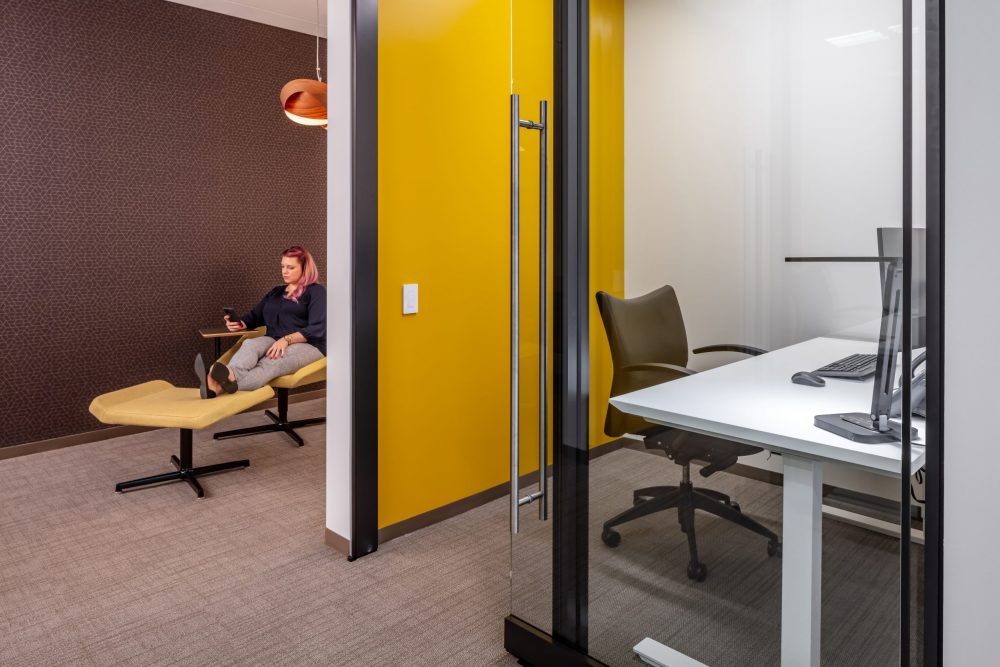NELSON Worldwide shares five behavior and attitude shifts they predict will have the heaviest impact on the corporate workplace along with recommendations for meeting these challenges.
In less than three months, COVID-19 has radically redefined how we relate to space and to each other. Compare today to March of this year: face masks are now an everyday accessory. We wait to enter grocery stores in six-foot-spaced queues without a second thought. And we cross the street to avoid people not as a snub, but to protect our health and others’. Sustained periods of hardship are known to change human psychology and behavior, sometimes permanently. Pandemic mitigation itself requires mass, coordinated behavioral change to succeed. As people return to offices in the coming months, we should expect those who have adapted to social distance and working from home to bring a set of new concerns, expectations and even unconscious reactions to situations that previously seemed harmless and normal. The importance of business continuity through the pandemic makes it incumbent upon employers to reshape the workplace to make workers feel comfortable, supported and able to do their jobs effectively.
The challenge is clear. Workplaces must adapt. Yet, how do we design a workplace that responds not just to fear and anxiety, or the invisible threat of germs, but the full range of learned behaviors and attitudes that have evolved through the COVID-19 crisis?
In the last decade, employers have increasingly prioritized employee wellness, including mental health, understanding that happiness and productivity go hand in hand. Many employers are initiating workplace assessments to identify where physical changes can help mitigate germs. If they go one step further to examine the problem holistically from the user perspective, taking into account COVID-19-related attitude and behavioral shifts, they will succeed in creating a powerful support tool for worker morale, public health and business continuity.
We’ve narrowed down a list of five behavior and attitude shifts we predict will have the heaviest impact on the corporate workplace along with recommendations for meeting these challenges.
1. People will have a newly heightened consciousness of space, surfaces and each other.
Feeling skittish around door handles these days? You’re not alone. One survey found three out of 10 people now try to avoid touching public surfaces such as doorknobs or elevator buttons. New hygiene products are surging and touchless technology has a renewed momentum. And the ever-robust discussion around the open-plan workplace is turning to de-densification.
How do we accommodate this new mentality about space and touch, to both aid in germ mitigation and create a comfortable, reassuring environment?
De-densification strategies must go beyond spacing between desks to consider workable circulation strategies. Planning for one-way circulation will reduce crowding, but to be successful, must include plenty of adjacent, prominently marked “step-aside” spaces to allow people to pass with adequate distance. Other areas that may draw crowds in an office, such as work cafes or kitchens, can be marked with floor and wall graphics to demonstrate how to keep distance, and well-marked queueing systems will control foot traffic into these areas. Graphics and signage must be clear and unambiguous, ideally supported by a strong communication strategy that makes office policies clear to employees.
Improving cleaning protocols within offices is never a bad idea, but COVID-19 has highlighted how valuable inherently disinfectant materials and finishes can be in indoor environments. Copper has received a lot of attention for its ability to kill off SARS-CoV-2 pathogens, and this is an option that can be used in a variety of fixtures and finishes. But we also have many other solutions available, for example, anti-microbial paint which can kill common pathogens such as staph, MRSA, and E. coli up to four years after application.
We are seeing a steady surge of interest in touchless technology for the office. IWMS systems are easily integrated with people’s mobile phones to allow them to book space or perform other normal functions without touching a single public surface. Technology will continue to play a huge role in navigating post-COVID requirements.

2. Personal safety will be a more conscious and constant concern.
Many people who never gave the invisible threat of germs a second thought pre-COVID may find themselves unusually preoccupied in these times. While all office workers have dealt with the threat of flu and colds in the workplace, the potential seriousness of exposure to COVID-19 has created, and demands, a new consciousness about personal and public safety. We should expect workers to return to offices with a keener awareness, and even anxiety, about personal safety.
Workplace design can provide supportive features to reinforce a sense of safety and empower employees to make good decisions for their personal needs. As mentioned before, offices will need to adopt exceedingly clear and consistent communication protocols in this time. Incorporating display space for office communications throughout the floor plan can help disseminate information quickly to keep changing policies or other critical information accessible at all times.
Signage plays an important role in this strategy. Signs that highlight what users can do as opposed to what they cannot in new layouts and settings may achieve higher engagement and reassurance.
In a time that has left many feeling so powerless, having a sense of control can help solidify feelings of safety. Incorporating more personal controls into workspaces for lighting, seating, and temperature/thermal, can enhance comfort and a sense of personal agency in the workspace.

3. Needs around mental health and well-being will increase.
Psychology experts are highlighting a range of mental health responses caused by the current crisis, from anticipatory grief to compounding effects on those living with depression. Added to economic and everyday work stress, the well-being of employees has never been so urgently in need of attention.
Employers who invest in wellness-related design strategies will help support worker morale in an unusually trying time. One example is striving to dedicate “work-free” zones in normal working areas where employees have easy access. This gives the nudge employees may need to take a break, have a coffee and recharge regularly throughout a stressful day, if getting out of the office seems too inaccessible.
Many offices may not strike the right balance between communal and private space. With open plan as the status quo these days, properly designed private space is extra important. For example, transparent phone booths give people individual space, but still lack the privacy people may need. Designating separate, quiet, calm and truly private rooms offers flexible support for heads-down work, personal phone calls, or just a restful break.
Other common strategies, such as biophilic design, ergonomic work settings and access to both active and meditative exercise activities, continue to be relevant and should receive more attention as we return to the office from lockdown.

4. Social distance will make the desire for community and connection even stronger.
From finding ways to sing together virtually to sharing meals via Instagram, COVID-19 has proven the resiliency of community and human connection in spite of physical distance. Areas where stay-at-home orders have started to lift are seeing surges in group activity, sometimes against local rules. As social creatures, people are understandably eager and ready to be together again to resume a sense of normalcy.
How do we enable that sense of community and togetherness in the workplace when social distancing is now a mandate? Adding to the challenge is the reality that many companies may phase in returning workers or institute shift policies, splitting up when people are in the office together.
One solution is providing centralized space that promotes the company’s common purpose or allows people to share and contribute team or personal stories. This can encourage employees to maintain a sense of community even when they’re not all together at once.
Zoom and video conferencing have kept connections alive across teams of colleagues working from home. With the likelihood that remote working will continue to be the norm, dedicating space that can host video calls for small and large groups will help bridge the gap between home and the office, keep people in touch and encourage the same type of virtual community-building that is happening now.

5. People will no longer view flexibility as an amenity, but as a must-have in their jobs going forward.
Public health experts warn to expect future outbreaks until we find a sustainable treatment or vaccine for COVID-19. We have seen how fragile our economy and systems can be, and yet the flexibility of corporate employers to accommodate remote working since the spread of the virus has created a lifeline for businesses across the world.
Flexible working arrangements allow employees to care for their children and elderly family, accomplish more at home during the week and save on commuting costs. Flexibility will no longer be a bonus or extra amenity going forward – it will be a necessity.
Employers have a range of options for integrating flexibility for the benefit of their employees. Planning space that supports employees working from home will provide a convenience for employees, but also potentially reduce cost of occupancy for employers. This requires nimble IT infrastructure, and as already mentioned, supportive spaces such as video conferencing rooms that keep home and office workers connected.
But flexibility in the space itself can give workers added, and much needed, room to breathe at this time. Activity-based settings that offer a range of spaces to use depending on mood, need or task allow employees to get work done in the environment they choose. And in a time when many workers from home are contending with children, partners, and limited space, what could be more comforting during the work day than that?
While there is no silver-bullet solution or perfect working environment, the current crisis offers opportunities to reshape the workplace and create spaces that are meaningfully centered on the human experience. Past pandemics have brought sea changes to design in many areas from how cities are planned to how bathrooms are finished. But perhaps never before have we seen such an urgency for the corporate office to adapt or fall behind. Tailoring workplace changes for the post-COVID mindset will tackle the challenges we face now and create more resiliency for businesses in the future.

